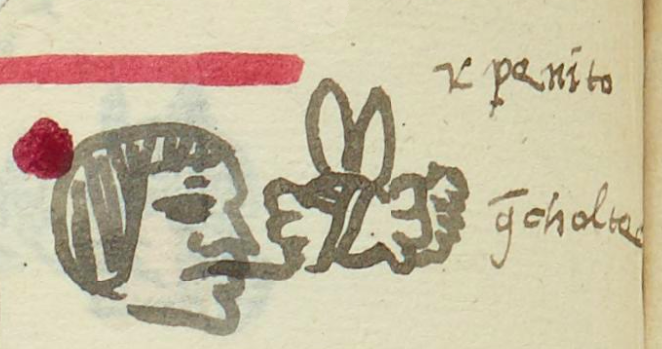Quecholteca (MH619v)
This black-line drawing of the compound glyph for the ethnicity Quecholteca ("People of Quechollan" or, if singular Quecholtecatl with letters in the binding, "Person of Quechollan") shows two quecholli feathers and a stone (tetl), the latter having a phonetic role in the suffix -teca (ethnic affiliation). An additional element appears on the right end of the stone, but how it contributes to the reading of the glyph is unclear. Perhaps it is a wing of a quecholli bird.
Stephanie Wood
The quecholli was a bird whose feathers had an important ritual role in the 20-day month of the same name. The beak may also be notable. Elizabeth Hill Boone translates Quechollan (the place name) as "Large Beaked Bird." [See her Stories in Red and Black (2000), 185.] This man, Benito Quecholteca, has a noteworthy orthographic feature in his first name, the use of "p" for b, and one in his Nahua name, where "g" is used for q.
Stephanie Wood
g~choltec[a]
Quecholteca
Stephanie Wood
1560
Jeff Haskett-Wood
birds, pájaros, plumas, feathers, Quechollan, etnicidad, afiliación, nombres de hombres

quechol(li), a bird, the bird's feathers, associated with a festival, https://nahuatl.wired-humanities.org/content/quecholli
te(tl), stone, https://nahuatl.wired-humanities.org/content/tetl-0
-teca, plural affiliation suffix, https://nahuatl.wired-humanities.org/content/teca-4
Gente de Quechollan
Stephanie Wood
Matrícula de Huexotzinco, folio 619v, World Digital Library, https://www.loc.gov/resource/gdcwdl.wdl_15282/?sp=321st=image.
This manuscript is hosted by the Library of Congress and the World Digital Library; used here with the Creative Commons, “Attribution-NonCommercial-ShareAlike 3.0 License” (CC-BY-NC-SAq 3.0).







